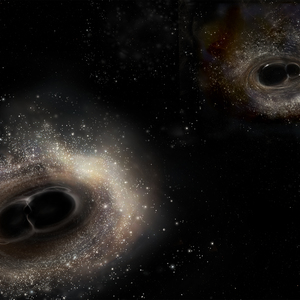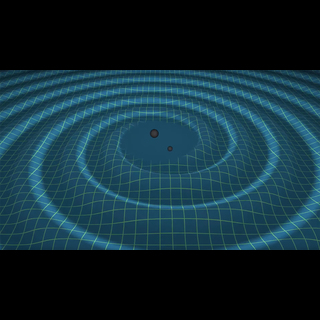
This artist's illustration depicts the merging black hole binary systems for GW150914 (left image) and GW151226 (right image). The black hole pairs are shown together in this illustration, but were actually detected at different times, and on different parts of the sky. The images have been scaled to show the difference in black hole masses. In the GW150914 event, the black holes were 29 and 36 times that of our Sun, while in GW151226, the two black holes weighed in at 14 and 8 solar masses. Image credit: LIGO/A. Simonnet.
LIGO Does It Again: A Second Robust Binary Black Hole Coalescence Observed
News Release • June 15, 2016
Jump to: Press release | Press conference | Resources | Contacts
Press release (PDF)
The two LIGO gravitational wave detectors in Hanford Washington and Livingston Louisiana have caught a second robust signal from two black holes in their final orbits and then their coalescence into a single black hole. This event, dubbed GW151226, was seen on December 26th at 03:38:53 (in Universal Coordinated Time, also known as Greenwich Mean Time), near the end of LIGO's first observing period ("O1"), and was immediately nicknamed "the Boxing Day event".
Like LIGO's first detection, this event was identified within minutes of the gravitational wave's passing. Subsequent careful studies of the instruments and environments around the observatories showed that the signal seen in the two detectors was truly from distant black holes – some 1.4 billion light years away, coincidentally at about the same distance as the first signal ever detected. The Boxing Day event differed from the LIGO's first gravitational wave observation in some important ways, however.
- The gravitational wave arrived at the two detectors at almost the same time, indicating that the source was located somewhere in a ring of sky about midway between the two detectors. Knowing our detector sensitivity pattern, we can add that it was a bit more likely overhead or underfoot instead of to the West or the East. With only two detectors, however, we can't narrow it down much more than that. This differs from LIGO's first detected signal (GW150914, from 14 September 2015), which came from the 'southeast', hitting Louisiana's detector before Washington's.
- The two merging black holes in the Boxing Day event were less massive (14 and 8 times the mass of our sun) than those observed in the first detection GW150914 (36 and 29 times the mass of our sun). While this made the signal weaker than GW150914, when these lighter black holes merged, their signal shifted into higher frequencies bringing it into LIGO’s sensitive band earlier in the merger than we observed in the September event. This allowed us to observe more orbits than the first detection–some 27 orbits over about one second (this compares with just two tenths of a second of observation in the first detection). Combined, these two factors (smaller masses and more observed orbits) were the keys to enabling LIGO to detect a weaker signal. They also allowed us to make more precise comparisons with General Relativity. Spoiler: the signal agrees, again, perfectly with Einstein’s theory.
- Last but not least, the Boxing Day event revealed that one of the initial black holes was spinning like a top! – and this is a first for LIGO to be able to state this with confidence. A spinning black hole suggests that this object has a different history –- e.g. maybe it 'sucked in' mass from a companion star before or after collapsing from a star to form a black hole, getting spun-up in the process.
With these two confirmed detections, along with a third likely detection made in October 2015 (believed also to be caused by a pair of merging black holes--see our paper draft on Black Hole Binaries in O1 for more information) we can now start to estimate the rate of black hole coalescences in the Universe based not on theory, but on real observations. Of course with just a few signals, our estimate has big uncertainties, but our best right now is somewhere between 9 and 240 binary black hole coalescences per cubic Gigaparsec per year, or about one every 10 years in a volume a trillion times the volume of the Milky Way galaxy! Happily, in its first few months of operation, LIGO’s advanced detectors were sensitive enough to probe deeply enough into space to see about one event every two months.
Our next observing interval – Observing Run #2, or "O2" – will start in the Fall of 2016. With improved sensitivity, we expect to see more black hole coalescences, and possibly detect gravitational waves from other sources, like binary neutron-star mergers. We are also looking forward to the Virgo detector joining us later in the O2 run. Virgo will be enormously helpful in locating sources on the sky, collapsing that ring down to a patch, but also helping us understand the sources of gravitational waves.
LIGO releases its data to the public. This open-data policy allows others to analyze our data, thus ensuring that the LIGO and Virgo collaborations did not miss anything in their analyses, and in the hopes that others will find even more interesting events. Our data are shared at the LIGO Open Science Center. GW151226 has its own page there.
We encourage you to wander around the LIGO Laboratory web page where you will find graphics to help you understand the Boxing Day observation, links to the press release, and pointers to scientific papers if you would like to dig in even deeper. There you will also find links to the LIGO Scientific Collaboration website, and to our sister collaboration, Virgo, both of which are central to these scientific results.
Published in PRL 116, 241103 (2016).
Press Conference
Press release (PDF)
Read the Press Release in other languages on the Detections page of the LIGO Scientific Collaboration (LSC)
Resources
Science summary of the GW151226 event, written for general public, at the website of the LIGO Scientific Collaboration.
Data release associated with the GW151226 event.
Audio
The "chirp" tones of the two LIGO detections are available for download. Formats are suitable as ringtones for either iPhone or Android devices. (Instructions for installing custom ringtones)
September 2015 Detection
December 2015 Detection
Detection Portal of the first detection of gravitational waves on Sep 14, 2015.
More resources about LIGO detections
Contacts
| LIGO Caltech MC 100-36 California Institute of Technology Pasadena, CA 91125 Information: (626) 395-2129 |
LIGO MIT MIT NW22-295 185 Albany Street Cambridge, MA 02139 Information: (617) 253-4824 |













